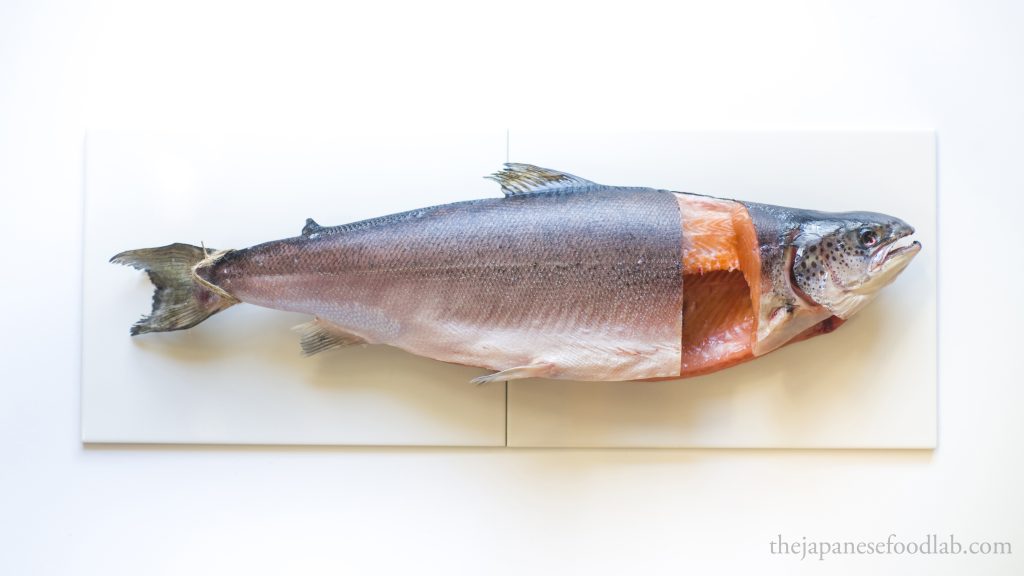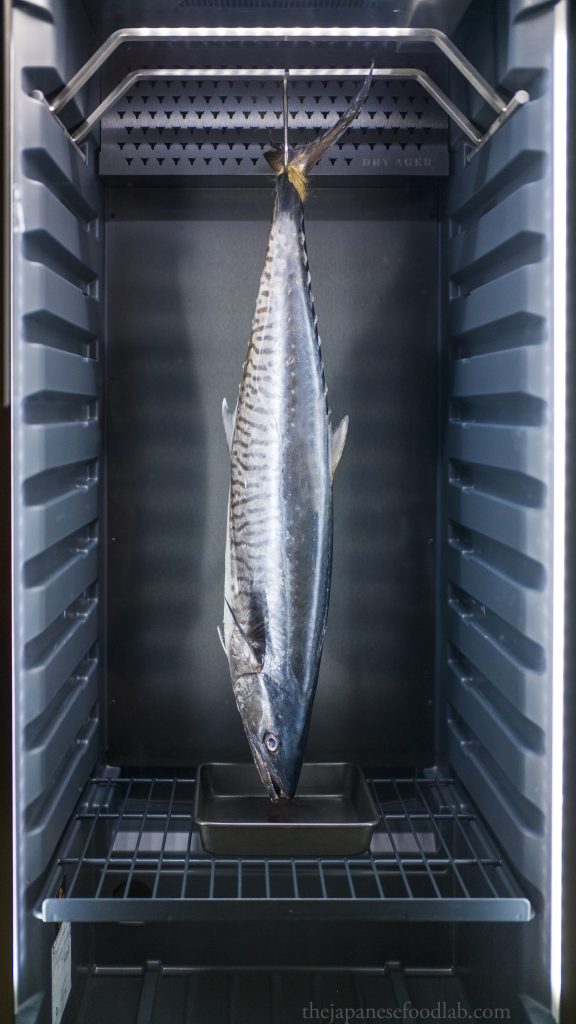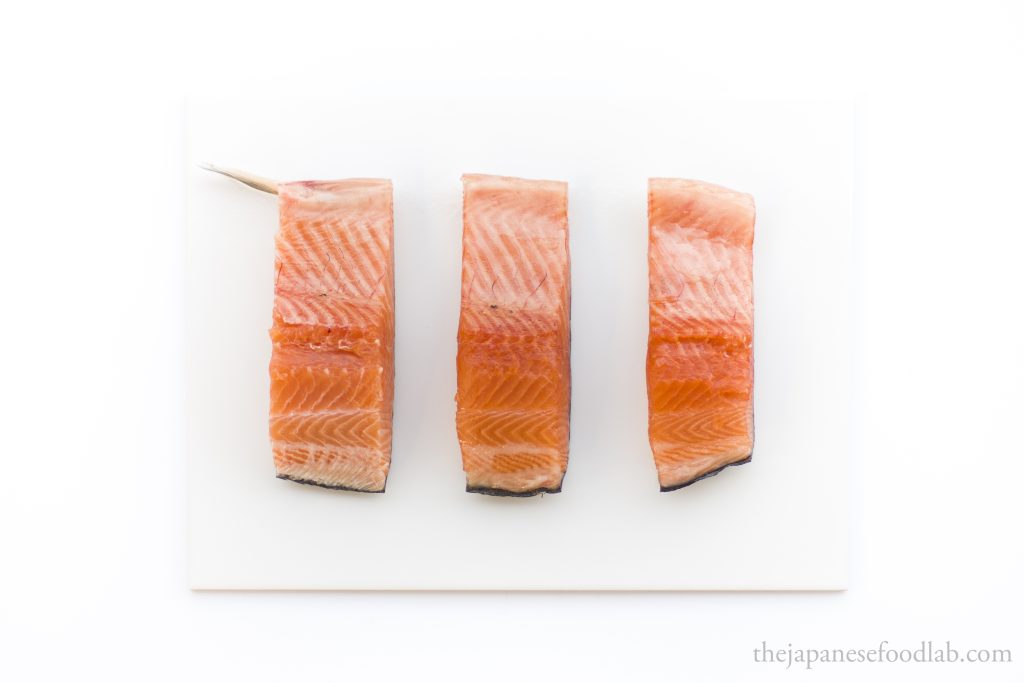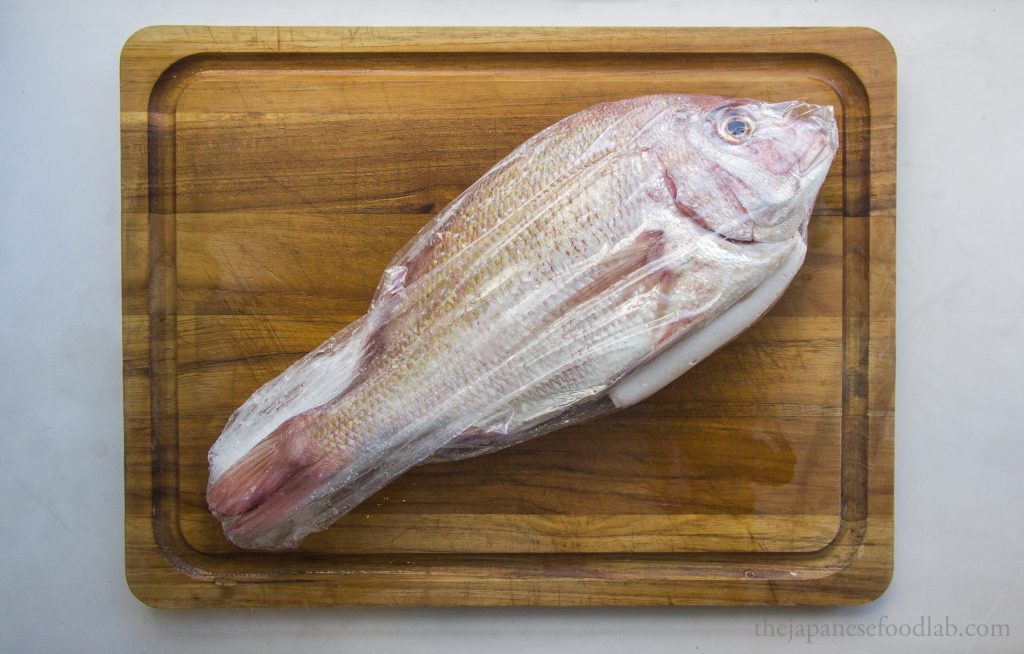This is the second article in our fish aging series. It is followed by how to choose fish for aging.
To truly appreciate the benefits of aging fish, we first need to understand the chemistry that occurs when a fish dies, before delving into how the way the fish is processed and aged affects these chemical changes.

Adenosine Triphosphate (ATP) and energy production
In fish (and in humans), energy is stored in the form of Adenosine Triphosphate (ATP) that is produced using oxygen during the process of aerobic respiration. When energy is needed during swimming, ATP is then able to bind to the fish’s muscles before breaking down into Adenosine Diphosphate (ADP) and phosphate, in the process releasing energy that is then used to power its muscle contractions.
Under normal circumstances, the remaining ADP molecule which is still bound to our muscles is then replaced with a new ATP molecule, which causes our muscles to relax. The process then repeats itself as muscle contraction continues.
The chemistry of fish rigor mortis
When fish die, respiration no longer continues which means that there is no longer oxygen available to produce new ATP. This means that there is no longer a constant supply of ATP available to replace ADP, which would result in the muscles of the fish being unable to relax as ADP remains bound to muscles.
Whilst respiration would have halted completely, electrical nerve messages from the brain and spinal cord signaling for muscle contractions do not stop. As muscle contraction continues to occur, more and more ADP is not replaced, and the entire body of the fish starts to stiffen up in a process known as rigor mortis.
The process of rigor mortis takes time to set in, typically 13 hours after the death of a human, and 15 to 24 hours in a fish depending on its size. If fish is still in a state of rigor mortis when prepared as sashimi, it will have what most people describe as a chewy and rubbery texture. This is because the muscles of the fish are still tightly contracted, making it hard for our teeth to chew and bite through.
How does rigor mortis affect the flavor of fish?
To better understand this, let’s first look at human exercise. During strenuous activity, our bodies require more ATP to supply the body with enough energy. This causes an increase in our breathing rate as our body tries to transport more oxygen to keep up ATP production. Unfortunately, our increased breathing rate is not enough to compensate for the increased demand of oxygen in our bodies.
When this occurs, our bodies start to generate ATP in the absence of oxygen through anaerobic respiration. This process is far less efficient and has the by-product of lactic acid (instead of carbon dioxide during aerobic respiration). As anaerobic respiration continues, we experience a build up of lactic acid as our bodies continue to produce ATP without oxygen. This build up of lactic acid is the cause of the muscle pains we feel during exercising (this is a slight over simplification).
A similar situation occurs in dead fish, where involuntary muscle contractions still occur without the supply of ATP from aerobic respiration. For this to occur, some ATP is still produced through the same process of anaerobic respiration, which would result in the same build up of lactic acid and pyruvic acid, causing an unpleasant sour taste to build up in the fish.

The case against mass sourced fresh fish.
All the information above builds a strong case for the many problems associated with mass sourced fish. When fish are caught out of the ocean, they’re often left to trash around in the open before suffocating due to the lack of oxygen. During this time, they not only build up a high amount of lactic acid from vigorous muscle contraction and aerobic respiration, but often get bruised and injured during the thrashing around.
This is not only highly unethical, but may also cause internal bleeding. This means that when and if the fish is bled, some of the blood still remains in the flesh, greatly shortening the shelf life. The fish then enters rigor mortis during transport back from the sea, and ideally will have relaxed by the time they reach the shop.
Fortunately for us, many of the problems in the taste and texture of fish resulting from rigor mortis can be mitigated through the handling and processing of the fish at the point of catching. Furthermore, it’s possible to take the edge off the effects of rigor mortis through a Japanese technique known as ikejime.
Many people believe that the use of ikejime combined with proper handling serve as the foundational steps prior to aging fish. To learn more about this, read our article on choosing and preparing fish for aging and our article on ikejime. Otherwise, you can also read our opinion.
Assuming that you’ve managed to source fish that has been handled and processed appropriately and now want to begin aging, you first need to decide if you’re going to wet age or dry age your fish. So what exactly is the difference and what is the underpinning chemistry?
The science of dry aging fish
Fish that are dry aged are typically hung or stored in a controlled environment of 70% to 85% relative humidity, and between 1°C to 2°C for anywhere between 3 days to 90 days.
During this time, enzymes naturally present in the cells of the fish start to break down the flesh from inside out. For an in depth explanation of enzymes, we recommend you read our article on what is koji? and the science of koji.
To summarize, enzymes are biological molecules that speed up the rate of chemical reactions. The enzymes we’re mainly concerned with here are proteases, which are a family of enzymes that break down different proteins.
Proteins are actually made from long chains of amino acids folded together. Making a wide generalization, there exist 20 amino acids that in different permutations of 50 to 2000 amino acids chains long, make up the vast majority of proteins we know.
Improved flavor complexity and umami
During dry aging, the various different proteases naturally present in the cells of fish start to act on the flesh of the fish itself by breaking apart the bonds between different amino acids in a protein chain. This causes the protein to break up into smaller segments and then into their constituent amino acids. The smaller segments also vary vastly in length, registering as different tastes and smells on our receptors, thus giving the fish a more complex taste.
Furthermore, as proteins are broken down into amino acids, some of the amino acids produced are glutamic acid and inosinic acid, which are responsible for the umami flavor of many natural foods such as mushrooms, cheese and tomatoes. As the concentration of these amino acids increases, so does our perception of the umami. This is why aged fish has a deeper savory taste compared to fresh fish.
Improved texture and mouthfeel
Texture-wise, the very same enzymes also start to break down the flesh and connective tissues of the fish, loosening muscles and structure. Because of this, dry aged fish has a much more sought after tender and melt in your mouth feel to it.
This also explains why it’s much easier to remove the pin bones from a filet of dry aged fish. The surrounding muscle tissues would have relaxed and broken down so much that you can easily pull out the entire length of the pin bone with minimal resistance and without any breakages.
Concentration of flavor
As the fish ages in a humidity between 70% to 85%, it slowly loses moisture to the environment through evaporation. During this time, the fish loses between 2-4% of total weight, slowly concentrating the flavors of the fish, making them more intense.
For more fatty varieties of fish such as tuna and salmon, the lipids or fats also undergo a small amount of oxidation, imparting the characteristic funky and meaty note that you might associate with dry aged beef.
Extremely crispy skin
As this loss of moisture occurs from the outside in, it is particularly noticeable on the skin of the fish, with a change in texture sometimes being visible in as short as 12 hours after the start of aging. As the skin dries out more and more over time, so does any slime or mucus on the skin surface.
The slime on fish consists of a mix of water, glycoproteins and polysaccharides. Glycoproteins are molecules with both a protein and sugar component, while polysaccharides are long chains of sugars. When mixed with sugar, they form a gelatinous layer of mucus that we call fish slime. This slime not only protects the fish against parasites and disease, but also reduces friction and the fish moves through water.
As the slime dries out, the glycoproteins and polysaccharides concentrate and form a dried out layer on the skin of the fish. When grilled or fried, the dried skin puffs up whilst the layer of slime caramelizes simultaneously, creating the most incredibly crispy skin unlike anything you’ve tasted before.

The downside of dry aged fish
Other than the prohibitively expensive start up cost to dry aging fish, probably the biggest shortcoming when dry aging fish is the minimum fish weight and size required to succeed. Due to moisture lost in the humidity controlled environment, smaller sized fish such as sardine and whiting can easily dehydrate before any improvements from dry aging develop. This can also happen to fish with a high surface area to volume ratios such as any flatfish like hirame, fluke or halibut, especially ones that are of a lighter weight. Therefore, your options for dry aging fish are confined to larger varieties of fish. From our experimentation, a minimum weight of around 1 kg is suitable for fish that are designated to be aged for 7 days for long.
If you intend to dry age fish but also remove portions of the fish day by day depending on consumption but cutting our small filets from the main body, we have found a minimum fish weight of around 3-4 kg to be ideal. This is because the exposed flesh of the fish from where the filet was removed will dry out to the point of inedibility and need to be cut away before cooking.
For fish smaller than 1kg, you can still dry age the fish for a couple of days, or even 24 to 26 hours without the fish drying out. However, you won’t obtain as pronounced a development in flavor. We recommend cuts of fish or smaller fish be aged on trays rather than hung from a hook.
Another drawback to dry aging fish occurs after fish have hung for more than 7-10 days. At this point, the enzymes have broken down so much of the muscle and connective tissue that the flesh starts to be unable to hold its shape. If eaten raw, the fish can start to take on an unpleasant mushy and soft texture. If you find that your knife starts to drag along the flesh and that applying pressure starts to compress and turn the meat to mush, then you know you’ve aged the fish for too long. At this point, we recommending turning the meat into either fish balls or fish paste (surumi/すり身) for either hotpot or tempura.
Certain fish such as spanish mackerel, Japanese spanish mackerel (sawara/鰆), certain cuts of tuna, and kingfish that can be be quite lean, contain a lot of connective tissues and are available in a large size are exceptions in that they be can aged for much longer depending on how they were processes and handled.
Fish that have been aged for too long can also develop off flavors of oxidized fat and overly funky notes in the same way that some people do not enjoy the taste of long dry aged beef.
It’s also worth noting that from our various experiments serving dry age fish to the uninitiated. We have found that some people think that the highly sought after crispy fish skin can sometimes be unpleasant. They find that the skin has dried up so much that it shatters in the mouth like glasses, giving it a sharp and splintering mouthfeel. This was more noticeable in larger fish with thicker skin. One way to alleviate this is through the sukibiki (すきびき) technique.

The science of wet aging fish
Wet aging fish is similar to dry aging in that fish are stored between 1°C to 2°C. However, they differ in that they’re not hung or exposed to the outside fridge environment, but instead stored in a sealed bag for a much shorter period of 3 to 6 days and up to 15 days in extreme circumstances.
Because the fish is stored in a sealed bag, the relative humidity of the fridge does not matter. While we’ve never measured the humidity inside the bag during wet aging, we feel that it’s safe to assume that it is a saturated environment (100% relative humidity). In such an environment, enzymes naturally present in the cells of the fish still function as elaborated on above, improving the taste and texture of the fish.
Any endeavor to age fish successfully is highly dependent on two competing processes- the growth of bacteria and action of the fish’s enzymes. During dry aging, bacteria growth is slowed greatly by the highly desiccating environment. However during wet aging, the saturated environment allows both processes to occur much quicker due to a higher water activity. Because of this, the improvement of flavor and texture occurs much quicker but so too does the deterioration of quality due to bacteria growth. This is why fish can only be wet aged for a much shorter period of time.
The benefit of wet aged fish
Compared to dry aging fish, there isn’t the same concentration of flavor due to water loss. However, the added benefit is that wet aged fish does not develop the nutty notes and aged funky taste that would detract from the natural taste of the fish. In comparison the flavor development in wet aged fish is much more subtle compared to dry aged fish.
This is particularly important when serving sushi as you want the guest to be able to enjoy the nuanced difference between fish, particularly during their height of seasonality. We feel that for applications such as an omakase course of various different pieces of sushi, having it consists of mostly dry aged fish, brings about a certain sameness to the taste of the fish.
Speed and efficiency
For restaurants with a lower capital, smaller space and higher turnover, the shorter time required to wet age fish can be highly beneficial. The cost of a dry age fridge is expensive and thinking back to the sushi restaurant I used to work at, the space was so small and the turnover for fish was so high that it would have been impossible to meet the customer demand with dry aging instead of wet aging.
What’s next?
Now that we’ve explored the chemical reactions that occur during dry and wet aging of fish, we can now explore how we choose and prepare fish for drying aging, before finally learning how to dry age and wet age fish.
Hello Philippe, I wanted to share my appreciation and thanks for your writing, knowledge, and this website. I’ve been passionate about fermentation and aging foods since entering the food science industry and I found your site while researching curing fish. I really love the detail you share and you will always have my support.